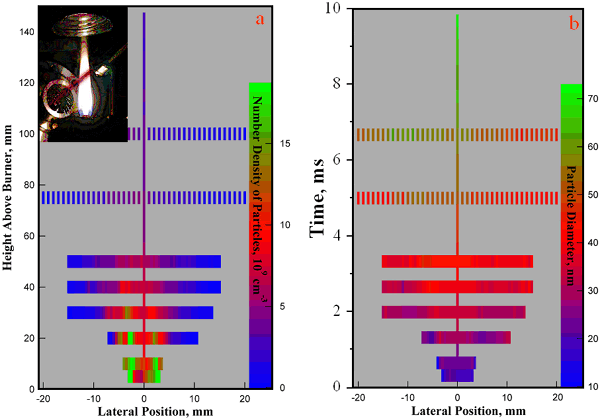- Home
- News
- Spotlight on Science
- In situ Study of...
In situ Study of Nanomaterial Growth in Flames
13-09-2004
Flame synthesis is one of the most versatile and promising technologies for large-scale production of nano-scale materials. Nanomaterials have distinctly different properties from bulk materials and understanding the mechanism of growth is pivotal to their controlled synthesis. So far, the in situ observation of particle growth in flames has been hampered by the high temperatures (~ 2000K), rapid kinetics (sub-millisecond scale), dilute growth conditions (parts per million by volume), and optical emission of synthetic flames. The high flux source and instrumentation at beamline ID02 provides a unique tool with which we have overcome these obstacles.
Share
2D mappings of nanoparticle size, particle size distribution and aggregation behaviour indicating nucleation and growth on size scales from 0.5 to 500 nanometres and on timescales as short as 100 microseconds were measured using high brilliance small-angle X-ray scattering (SAXS).
The synthetic flame was produced with a methane and oxygen mixture to which the precursor hexamethyldisiloxane was fed. A highly collimated and intense monochromatic X-ray beam (size 300 micrometres) passed through the flame. The scattered intensity in the forward direction was recorded by a two dimensional detector housed inside the 10 metre evacuated flight tube.
The results support simple diffusion-controlled nanoparticle growth laws that were used to model the data and encourage current attempts at simulation and modelling of nanoparticle growth while offering a technique for direct verification of these predictions. Work in progress extends the studies to nanometre-scale aerosols of toxicological and environmental concern.
Principal Publication and Authors
G. Beaucage, H.K. Kammler, R. Mueller, R. Strobel, N. Agashe, S.E. Pratsinis, and T. Narayanan, Probing the dynamics of nano-particle growth in a flame using synchrotron radiation, Nature Materials, 3, 370 (2004).




